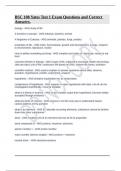BSC 108 Yates Test 1 Exam Questions and Correct
Answers.
biology - ANS study of life
3 domains or groups - ANS eukarya, bacteria, archae
4 kingdoms in Eukarya - ANS animalia, plantae, fungi, protista
properties of life - ANS order, homeostasis, growth and development, energy, respond
to environment, reproduce, evolve
How to define something as living - ANS complex and made of chemicals, needs to eat
food
common themes in biology - ANS scope of life, organisms exchange matter and energy,
cells are basic unit of life, continuous life based on DNA, diverse life forms, evolution
scientific method - ANS used to explain or answer questions about data, observe,
question, hypothesize, predict, experiment, analyze
hypothesis - ANS tentative explanation for an observation
components of hypothesis - ANS support or reject hypothesis with data, not all can be
investigated scientifically, must be testable
what is a theory in science - ANS much broader scope than hypothesis, become widely
accepted through evidence
what are limits of science - ANS science is not the only way to understand nature,
cannot address every question
what is an element - ANS 92 naturally occurring elements, substance cannot be broken
down into other substances
atom - ANS smallest unit of an element that has all of its properties
atom composed of - ANS protons, neutrons, electrons
atomic number = - ANS proton number
mass number (atomic weight) - ANS protons + neutrons
neutral atom: - ANS elections=protons
, ion - ANS element that has gained or lost an electron
isotope - ANS element containing different numbers of neutrons
how are isotopes and fossils connected - ANS half life and radioactivity living through
fossils
energy - ANS capacity to do work, make a change in matter; potential energy is stored
in bonds, kinetic is doing work
neutral atom - ANS atom with no charge, number of electrons = number of protons
trace element - ANS required in very small amounts but cannot live without them
radioactive isotope - ANS nucleus decays, giving off particles and energy; exposure can
harm living things
electrons in energy shells - ANS 1st shell: 2 electrons
2nd shell: 8 electrons
3rd shell: 8 electrons
types of chemical bonds - ANS covalent (single or double): sharing of electrons -
strongest bond; ionic: attraction between + and - ions - moderate; hydrogen: unequal
sharing of electrons - weakest
beginning material in chemical reactions - ANS reactants
ending material in chemical reaction - ANS products
why can water absorb a lot of heat - ANS high heat of vaporization, breaking of
hydrogen bonds
ice floats - ANS water freezes, expands, and floats due to formation of crystalline
structure; less dense than liquid water
importance of ice floating - ANS if ice did not float, everything would freeze and
therefore life would not exist below surface
Solution, solvent, and solutes - ANS solution: liquid that is homogenous mixture of 2+
substances (salt water)
Solvent: dissolving agent (water)
Solute: dissolved substance (salt)
Properties of water - ANS hydrophilic: water loving, polar
Hydrophobic: water fearing, non-polar




